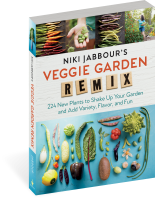Five Annual and Perennial Pairs for your Vegetable Garden
Loosen up the traditional “rules” of gardening to create space for new ideas like planting perennial flowers with your vegetables.
It’s long been a fairly stringent rule that in the case of edibles, you should keep annuals and perennials separate: Plant annuals with annuals and plant perennials apart from annuals in separate beds. Why?

In my garden, a few perennial herbs and flowers mingle among the annuals year after year. I’m not claiming the following are true companions in the sense of benefiting one plant by reducing pests or disease, but they have grown together successfully and beautifully.
SAGE + BROCCOLI Folk wisdom considers sage a companion for plants in the mustard family such as arugula, kale, and broccoli. The strong scent of sage may confuse cabbageworm moths that like to lay eggs on mustard-family crops.
ECHINACEA + TOMATOES I love the bright blooms of echinacea (coneflower) that come back each summer. The color complements the green tomato plants and brightens up the bed until the fruit starts to mature. Bees also love echinacea.

VERONICA + SQUASH I first found veronica when I was looking for an in-bloom plant that bees might love. In the garden center, the display of veronica plants was literally shaking with bee activity, and it’s been that way in my garden, too. Veronica is a good partner for squash, which needs ample pollination from bees.
STRAWBERRIES + LETTUCE Strawberries grow a strong root system, so they pair well with lettuce, which is lightly rooted. These spring berries and greens also go together in the kitchen and make a great combo in planting containers.
THYME + PEPPERS Low-growing thyme can develop well underneath peppers, shading the soil and perhaps deterring some pests with its scent. Growing peppers above thyme also makes good use of space.
Excerpted and adapted from The Creative Vegetable Gardener © by Kelly Smith Trimble.
With The Creative Vegetable Gardener, lifestyle editor and master gardener Kelly Smith Trimble encourages readers to widen their focus, be playful, and imagine a vegetable garden that reflects their own unique aesthetic and offers a meditative sanctuary as well as a source of fresh, homegrown food. From seed selection to garden layout and regenerative gardening practices, gardeners of all levels will find Smith Trimble's liberating advice a pathway to making the garden a place of nourishment for the soul and creative spirit, while also feeding the body.










